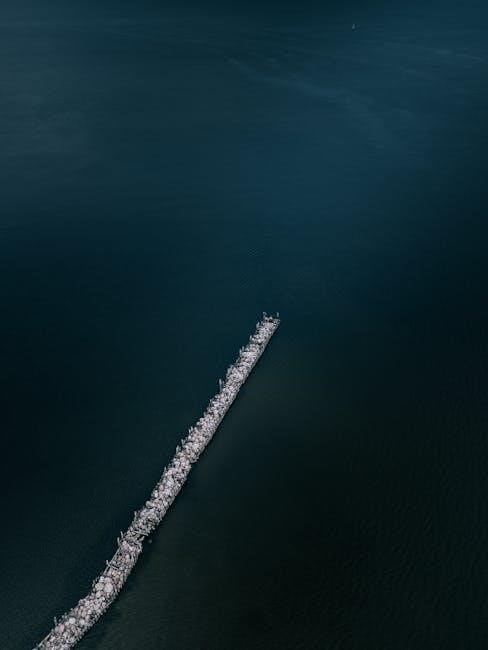The PADI Open Water Diver Manual is a comprehensive guide for beginners‚ covering essential diving principles‚ safety protocols‚ and practical skills. It serves as the foundation for certification‚ ensuring a safe and enjoyable diving experience.
1.1 Overview of the PADI Open Water Diver Course
The PADI Open Water Diver Course is a structured program designed to teach beginners the fundamental skills and knowledge needed for safe and enjoyable scuba diving. The course is divided into three main phases: classroom instruction‚ confined water training‚ and open water dives. In the classroom‚ students learn diving principles‚ safety procedures‚ and equipment usage through the PADI Open Water Diver Manual and instructional videos. Confined water sessions allow divers to practice skills in a controlled environment‚ such as breathing underwater‚ buoyancy control‚ and emergency procedures. Finally‚ open water dives provide real-world application of these skills in natural settings‚ ensuring divers are comfortable and confident. Upon completion‚ participants receive the PADI Open Water Diver certification‚ enabling them to dive independently worldwide.
1.2 Purpose of the Manual
The PADI Open Water Diver Manual is designed to provide students with a comprehensive understanding of scuba diving principles‚ safety guidelines‚ and practical skills. Its primary purpose is to serve as a detailed textbook for the Open Water Diver course‚ ensuring that learners gain the knowledge and confidence needed to dive safely and independently. The manual covers essential topics such as diving physics‚ equipment usage‚ underwater navigation‚ and emergency procedures. It also emphasizes the importance of safety protocols and responsible diving practices. By following the manual‚ students can prepare for both classroom sessions and practical training‚ ultimately achieving their PADI certification. The manual is a vital resource for anyone seeking to become a competent and responsible scuba diver.

Key Features of the PADI Open Water Manual
The manual includes detailed diving theory‚ visual aids‚ and practical skill descriptions. It emphasizes safety‚ proper techniques‚ and environmental awareness‚ making it an indispensable resource for new divers.
2.1 Essential Content Covered
The PADI Open Water Diver Manual covers fundamental diving concepts‚ including diving physics‚ physiology‚ and environmental considerations. It outlines safety procedures‚ equipment usage‚ and emergency protocols. The manual also details buoyancy control‚ underwater navigation‚ and dive planning‚ ensuring a comprehensive understanding of essential skills. Each section is designed to build a strong foundation for safe and confident diving practices. By addressing both theoretical and practical aspects‚ the manual prepares students for real-world diving scenarios.
2.2 Visual Aids and Illustrations
The PADI Open Water Diver Manual incorporates detailed visual aids‚ including diagrams‚ charts‚ and photographs‚ to enhance understanding of diving concepts. These illustrations simplify complex topics like equipment assembly‚ hand signals‚ and underwater navigation. High-quality images and step-by-step guides help learners visualize procedures‚ such as buoyancy control and emergency protocols. The manual also uses color-coded sections and infographics to organize information‚ making it easier to follow. These visual elements complement the text‚ ensuring that students can grasp both theoretical and practical aspects of diving. The use of clear and concise visuals makes the manual an engaging and effective learning tool for aspiring divers.
2.3 Practical Skills Section
The PADI Open Water Diver Manual dedicates a detailed section to practical skills‚ ensuring students master essential diving techniques. This part focuses on hands-on training‚ covering key abilities such as buoyancy control‚ underwater navigation‚ and emergency procedures. Clear instructions and step-by-step guides help learners understand and execute skills like mask clearing‚ regulator recovery‚ and underwater breathing. The manual emphasizes practice in both confined and open water environments to build confidence and competence. By reinforcing these practical skills‚ the manual prepares divers to handle various underwater scenarios safely and effectively. This section is crucial for transforming theoretical knowledge into real-world diving proficiency‚ making it a cornerstone of the PADI certification process.

Course Structure
The PADI Open Water course structure includes classroom sessions‚ confined water training‚ and four open water dives over three days in tropical waters.
3.1 Classroom Sessions
The classroom sessions provide the theoretical foundation for the PADI Open Water Diver course. Students learn diving principles‚ safety procedures‚ and terminology through interactive lessons and video materials. These sessions cover essential topics like dive planning‚ underwater navigation‚ and equipment usage‚ all outlined in the manual. Instructors guide students through the material‚ ensuring understanding and addressing questions. The classroom phase emphasizes the importance of safety and prepares divers for practical training. Students are encouraged to highlight and underline key sections in their manuals for quick reference. The sessions also include quizzes and exams to assess knowledge retention. By completing the classroom sessions‚ students gain the confidence and knowledge needed to progress to confined water training and open water dives. The manual serves as a vital resource‚ reinforcing concepts discussed in class and providing detailed explanations for further study. This phase is crucial for building a strong foundation in scuba diving principles and practices.

3.2 Confined Water Training
Confined water training is the next phase after classroom sessions‚ where students apply theoretical knowledge in a controlled environment‚ such as a swimming pool. This phase focuses on developing basic scuba diving skills‚ including buoyancy control‚ breathing underwater‚ and equipment usage. Instructors demonstrate techniques‚ and students practice until they feel comfortable. The manual reinforces these skills with detailed descriptions and illustrations‚ ensuring a clear understanding. Confined water training also introduces emergency procedures‚ such as mask clearing and regulator recovery‚ to build confidence and competence. The sessions are structured to gradually increase complexity‚ allowing students to master each skill before progressing. This hands-on experience is essential for preparing divers for the challenges of open water dives. The confined water phase is a critical step in becoming a certified PADI Open Water Diver.
3.3 Open Water Dives
Open water dives mark the final stage of the PADI Open Water Diver course‚ conducted in natural settings like oceans or lakes. These dives allow students to apply skills learned in confined water to real-world conditions. Over two days‚ students complete four dives‚ each focusing on specific objectives‚ such as underwater navigation‚ depth management‚ and buoyancy control. Instructors assess students’ ability to perform safety procedures‚ like decompression stops and emergency ascents. The final dive is often a recreational experience‚ enabling students to enjoy the underwater environment while demonstrating their mastery of skills. Open water dives are crucial for building confidence and ensuring readiness for independent diving. Upon successful completion‚ students are awarded the PADI Open Water Diver certification‚ qualifying them to dive worldwide without professional supervision.

Sections of the Manual
The manual is divided into key sections‚ including safety procedures‚ dive planning‚ and underwater navigation techniques‚ each providing detailed guidance for safe and effective diving practices.
4.1 Safety Procedures and Protocols

The PADI Open Water Diver Manual emphasizes rigorous safety procedures and protocols to minimize risks. It outlines emergency response plans‚ proper equipment usage‚ and pre-dive checks. Divers learn about air supply management‚ depth limits‚ and buddy systems. The manual stresses the importance of adhering to safety guidelines to prevent accidents and ensure a safe diving experience. These protocols are designed to protect divers and promote responsible diving practices.
4.2 Dive Planning and Management
Dive planning and management are critical components of the PADI Open Water Diver Manual. The manual outlines a structured approach to planning dives‚ including setting clear objectives‚ assessing environmental conditions‚ and creating a detailed dive plan. Divers learn how to use tools like the PADI Recreational Dive Planner or electronic dive computers to ensure safe depth and time limits. The manual also emphasizes the importance of pre-dive briefings‚ underwater navigation‚ and post-dive procedures. Proper planning helps minimize risks and ensures a safe‚ enjoyable experience. The section also covers how to adapt plans based on changing conditions and how to communicate effectively with dive buddies. By following these guidelines‚ divers can manage their dives confidently and responsibly.

4.3 Underwater Navigation Techniques
The PADI Open Water Diver Manual dedicates a section to underwater navigation‚ teaching divers how to confidently find their way during dives. Techniques include natural navigation using landmarks and underwater features‚ as well as compass navigation for precise direction. The manual explains how to use a dive compass effectively‚ including setting a course and following reciprocal headings. It also covers estimating distance underwater‚ which is challenging due to water refraction. Practical exercises‚ such as the compass swim and navigation patterns‚ are outlined to help divers master these skills. These techniques ensure divers can return to their starting point or boat safely‚ enhancing both safety and enjoyment underwater.

Additional Resources
The PADI Open Water Manual offers additional resources‚ including supplementary online materials‚ training videos‚ and downloadable PDF guides‚ enhancing your understanding and preparation for certification.
5.1 Supplementary Online Materials
Supplementary online materials for the PADI Open Water Manual include interactive PDFs‚ training videos‚ and digital guides. These resources provide detailed dive theory and practical skills.
5.2 Training Videos and Tutorials
Training videos and tutorials complement the PADI Open Water Manual by offering visual demonstrations of key diving skills and concepts. These resources cover topics such as buoyancy control‚ underwater navigation‚ and emergency procedures. Available on platforms like YouTube and PADI’s official website‚ these tutorials provide step-by-step guidance‚ making complex techniques easier to understand. Many videos are accompanied by interactive content‚ allowing learners to engage deeply with the material. They also serve as a valuable review tool for divers preparing for certification. By combining theoretical knowledge from the manual with practical video demonstrations‚ learners can enhance their understanding and confidence. These tutorials are particularly useful for visual learners and those seeking additional support beyond the written manual. Accessible online‚ they offer flexibility for divers to study at their own pace.

Downloading the Manual
The PADI Open Water Diver Manual is available in PDF format on platforms like PDFDrive‚ Scribd‚ and PADI’s official website. File sizes range from 23MB to 838.5MB.
6.1 Sources for PDF Download
The PADI Open Water Diver Manual in PDF format is accessible through various online platforms. Popular sources include PDFDrive‚ Scribd‚ and PADI’s official website. Additionally‚ websites like Alib;ru and GetCourse.ru offer downloads‚ ensuring easy access for learners. The manual is also available through PADI-associated dive shops and training centers. File sizes typically range from 23MB to 838;5MB‚ depending on the edition and quality. To ensure authenticity and safety‚ it’s recommended to download from verified sources like PADI’s official library or authorized distributors. Always verify the source to avoid unauthorized or outdated versions of the manual.
6.2 Tips for Effective Use
For effective use of the PADI Open Water Diver Manual PDF‚ consider the following tips. First‚ download the manual from verified sources like PADI’s official website or authorized platforms to ensure authenticity. Once downloaded‚ use tools like highlighters or note-taking apps to mark important sections. Pay attention to visual aids‚ as they simplify complex concepts. Prioritize sections on safety procedures and dive planning to build a strong foundation. Additionally‚ cross-reference the manual with PADI’s training videos for a deeper understanding. Regularly review the content‚ especially before dives‚ to reinforce learning. Lastly‚ ensure your device has adequate storage and a reliable PDF viewer for seamless access. By following these tips‚ you can maximize the manual’s benefits and prepare effectively for your certification.

Importance and Conclusion
The PADI Open Water Diver Manual is crucial for safe diving practices‚ providing essential knowledge and skills. It is a necessity for certification and lifelong diving enjoyment.
7.1 Why the Manual is Crucial for Certification
The PADI Open Water Diver Manual is indispensable for certification‚ as it provides foundational knowledge and skills essential for safe diving practices. It outlines diving principles‚ safety protocols‚ and practical techniques‚ ensuring students understand the fundamentals. The manual is a primary resource for completing the course‚ covering topics like buoyancy‚ underwater navigation‚ and emergency procedures. It also includes step-by-step instructions for developing critical diving skills. By mastering the content‚ students can confidently progress through the certification process and meet PADI standards; The manual serves as a reference guide‚ reducing risks by promoting adherence to best practices. Ultimately‚ it equips divers with the knowledge and confidence needed for safe and successful diving experiences worldwide.
7.2 Final Thoughts and Recommendations
The PADI Open Water Diver Manual is a vital resource for anyone pursuing scuba diving certification. It provides a clear‚ structured approach to learning‚ ensuring divers are well-prepared for both theoretical and practical aspects. The manual’s comprehensive coverage of safety protocols‚ diving techniques‚ and environmental awareness makes it an indispensable tool. For optimal use‚ divers should thoroughly review each section‚ complete associated exercises‚ and apply the knowledge during training sessions. Additionally‚ leveraging supplementary materials‚ such as training videos‚ can enhance understanding. By following the manual’s guidelines and adhering to best practices‚ divers can gain confidence and skills‚ leading to a safe and enjoyable diving experience. It is highly recommended for all aspiring divers to utilize this manual as their primary study guide.


